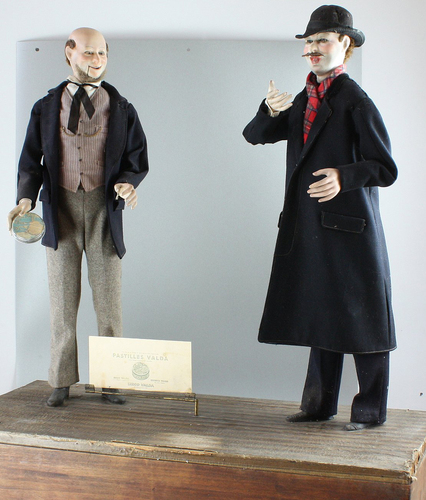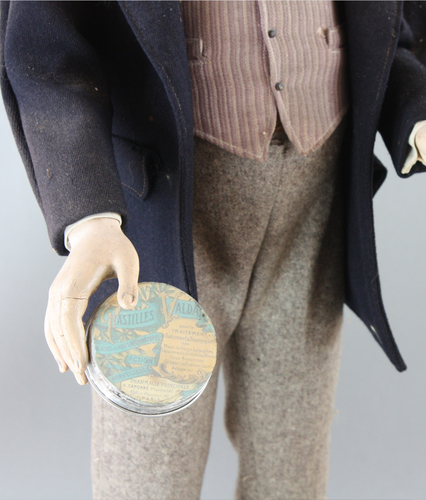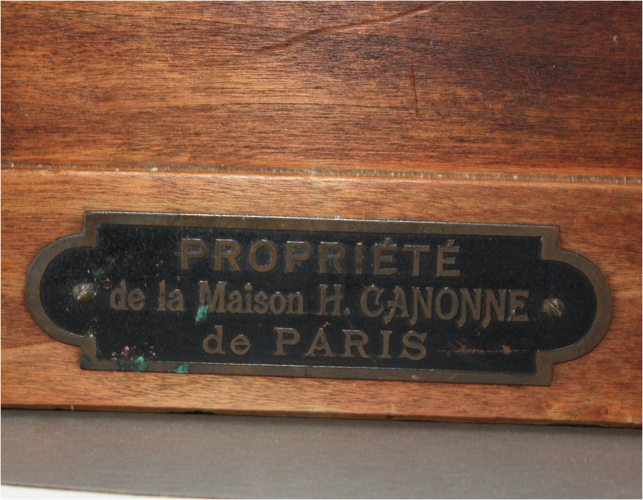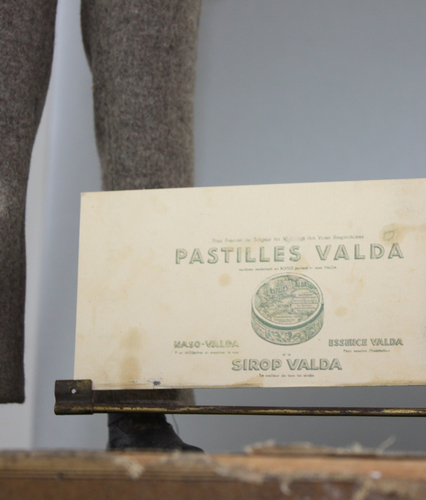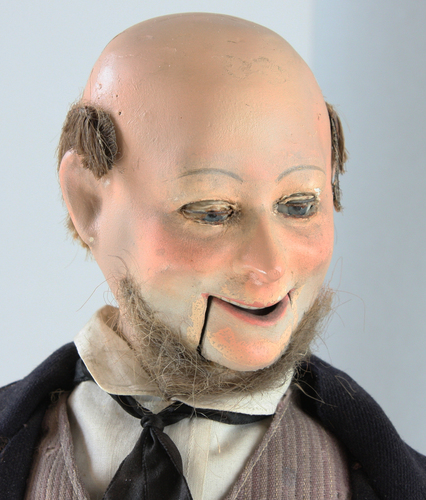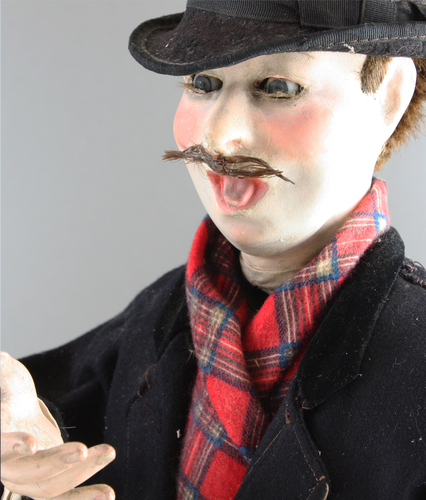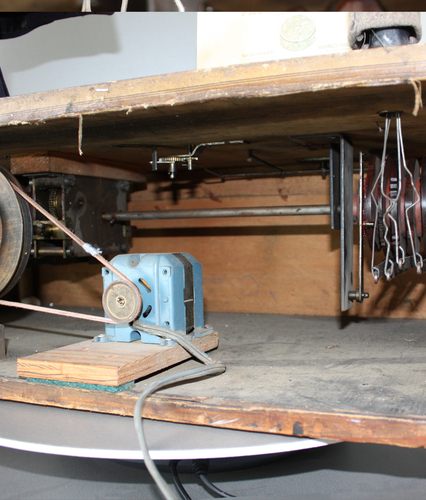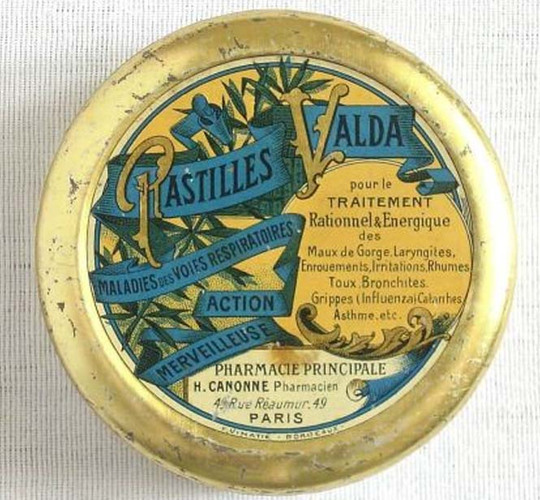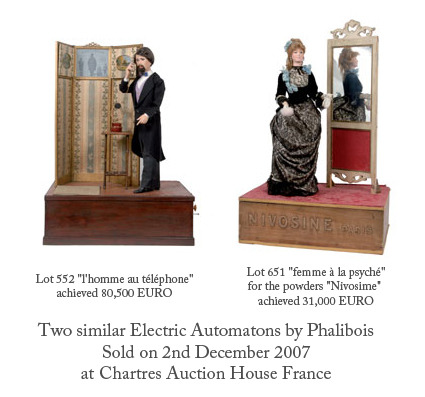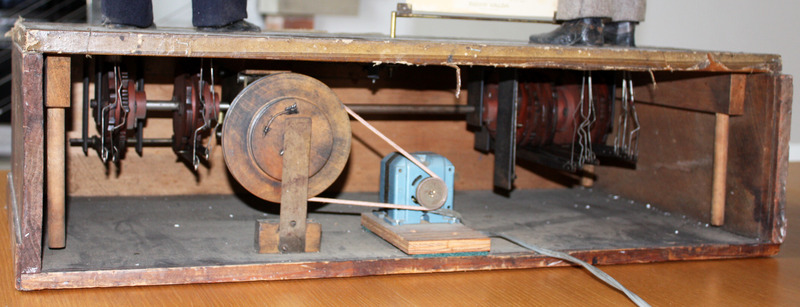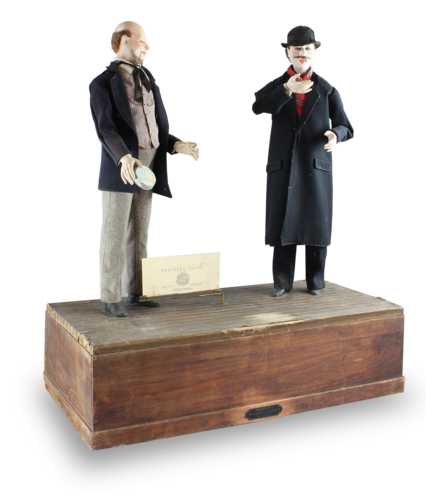
A large and rare Antique electric Valda Throat Pastilles window display automaton, by Phalibois
A large and very rare antique electric Valda Throat Pastilles window display automaton, by Phalibois,
Circa 1910
built for exclusive use by H. Canonne pharmacy of Paris,
The first generation Phalibois electric driven automaton model, many actions including true-to-life breathing motion,
Let's do something about that nasty cough...
When connected to the mains power supply, the two full length standing figures realistically act out the scene with the helpful gentleman on the left dressed in grey trousers, with a white shirt with black waistcoat, black three-quarter length jacket, ribbon tie and black shoes. He has a finely painted papier-mâché head with articulated jaw and bushy sideburns and a bald patch, blinking both eyes.
He has an extremely rare chest breathing motion, moving his head side to side in sympathy with the sufferer and then up and down with his jaw moving to indicate speech. He raises and lowers his left arm to accentuate his point of view, while his right hand holds a circular Valda Pastilles tin and offers the coughing man the answer to his problems.
The coughing gent is dressed in a long black coat with red tartan neck scarf, dark trousers and shoes, black bowler hat. He has a finely painted papier-mâché head with open mouth and with his tongue poking out slightly. He has a Daliesque moustache and curly hair and blinking eyes; he moves his head up and down and from side to side in despair. He bends from the waist up, bending back and forth then suddenly placing his right hand over his mouth to cough whilst his left arm holds his chest. Once a pastille is offered, the double-sided sepia lithographed product sign showing the company title and details revolves a full half turn between and then returns.
The stained pine trunk box base containing the full movement is driven by an early dynamo-type electric motor to a direct belt drive flywheel. Power is distributed by universal gearbox to two groups of running cam blocks, with the smaller group of two driving the helpful gent while the larger block of eight are for the coughing figure. The last cam on this run has a side running burr for linkage to the flag turning rod; each cast metal rod lever has a sprung return.
The black brass plaque to the front centre incised with PROPRIÉTÉ de la Maison H. CANONNE de PÁRIS.
In full working order with full original dress and components.
Size: 80cm wide, 40cm deep by 93cm tall
Point of interest -
These early electric automatons are extremely rare, we have been only able to find two other similar models that have been sold, both were sold through the french auction house Chartres on December 2nd 2007.
Lot 552 "l'homme au téléphone" (a man at the telephone) achieved 80,500 EURO from a pre sale estimate of 50,000 - 70,000 EURO
In the same sale a simpler one figure electric automaton of the same size Lot 651 "femme à la psyché", or "Hortense Schneider" A large advertising automaton for the powders "Nivosime" achieved 31,000 EURO from a pre sale estimate of 20,000 - 30,000 EURO
Neither of these two automatons had the rare function of breathing seen on our model and neither had as many movements as ours, Lot 651 was a much simpler one figure automaton with a far less complicated movement simply showing a lady powdering her face in a mirror. The addition of the breathing creates what is probably one of the most realistic automatons the Phalibois firm ever produced.
There is an unofficial family tree of drive types for automatons through the history of the subject.
The very first types were recorded as moving statues in gardens of ancient Greece which were weight and water powered, but by the 18th ad 19th centuries, most automatons were spring driven and for longcase clocks, sometimes weight driven, governed by the pendulum.
When Edison perfected his electric motor in the 1880s, making the design smaller and quieter, it was only going to be a matter of time until the use of spring power was phased out.
By 1900, parts of towns and cities had an electrical power supply, albeit primitive, but a useful source of power whilst in the eyes of many, still a new fad which deserved suspicion.
Just before 1910 and with the acquisition of access to Bontems' workshops and designs, Phalibois saw the electrical power potential on an entrepreneurial scale and made good use of it. The first to do so and the only well known and respected automata firm to really design and make good reliable examples with contracts made with large firms for product advertising.
Of the contracts, the two largest were Valda and Z lamps (electric light bulbs). That Z lamp automaton used a similar body cast of the helpful gent as the standing man with a lit bulb on pine box base. Here two figures run with many movements and realistic actions make for quite a scene.
As an observer through the chemists window at this who had never seen electricity used to drive such an object, it must have been both terrifying and wonderful at the same time.
Breathing motions were first devised by Vichy and were used by him for his doll and standing male figure automatons. This motion really brings the figure to life, literally, as all movements he conveys are true to human kind. A simple yet astonishing display of what is possible with the right rods in the right places.
So now we need to help this poor man with a sore throat - lets switch on and see what happens...
Reference - The Golden Age of Automata (C. Bailly), 1987, pp.156-157 for full first generation electric-driven automatons by Phalibois.
| STOCK No | 1433 |
| AVAILABILITY | Sold |
| PRICE | Sold |


